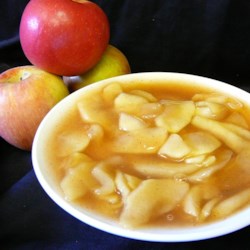sister herb
Official TTI Chef
...keeps a doctor away.

The proverb "An apple a day keeps the doctor away", addressing the health effects of the fruit, dates from 19th century Wales when Caroline Taggart, author of “An Apple a Day: Old-Fashioned Proverbs and Why They Still Work.” coined a saying in Pembrokeshire in Wales. The original phrase, Taggart said, was, ‘‘Eat an apple on going to bed, and you’ll keep the doctor from earning his bread.” In the 19th century and early 20th, the phrase evolved to “an apple a day, no doctor to pay” and “an apple a days sends the doctor away,” while the phrasing now commonly used was first recorded in 1922.

The apple tree (Malus domestica) is a deciduous tree in the rose family best known for its sweet, pomaceous fruit, the apple. It is cultivated worldwide as a fruit tree, and is the most widely grown species in the genus Malus. The tree originated in Central Asia, where its wild ancestor, Malus sieversii, is still found today. Apples have been grown for thousands of years in Asia and Europe, and were brought to North America by European colonists. Apples have religious and mythological significance in many cultures, including Norse, Greek and European Christian traditions.
Apple trees are large if grown from seed, but small if grafted onto roots (rootstock). There are more than 7,500 known cultivars of apples, resulting in a range of desired characteristics. Different cultivars are bred for various tastes and uses, including cooking, eating raw and cider production.
The center of diversity of the genus Malus is in eastern Turkey. The apple tree was perhaps the earliest tree to be cultivated, and its fruits have been improved through selection over thousands of years. Alexander the Great is credited with finding dwarfed apples in Kazakhstan in Asia in 328 BCE; those he brought back to Macedonia might have been the progenitors of dwarfing root stocks. Winter apples, picked in late autumn and stored just above freezing, have been an important food in Asia and Europe for millennia.
Apples are often eaten raw. The whole fruit including the skin is suitable for human consumption except for the seeds, which may affect some consumers. The core is often not eaten and is discarded. Varieties bred for raw consumption are termed dessert or table apples.
Apples can be canned or juiced. They are milled or pressed to produce apple juice, which may be drunk unfiltered (called apple cider in North America), or filtered. The juice can be fermented to make cider (called hard cider in North America), ciderkin, and vinegar. Through distillation, various alcoholic beverages can be produced. Apple seed oil and pectin may also be produced.
Nutrition: a typical apple serving weighs 242 grams and contains 126 calories with significant dietary fiber and modest vitamin C content, with otherwise a generally low content of essential nutrients.
The proverb "An apple a day keeps the doctor away", addressing the health effects of the fruit, dates from 19th century Wales when Caroline Taggart, author of “An Apple a Day: Old-Fashioned Proverbs and Why They Still Work.” coined a saying in Pembrokeshire in Wales. The original phrase, Taggart said, was, ‘‘Eat an apple on going to bed, and you’ll keep the doctor from earning his bread.” In the 19th century and early 20th, the phrase evolved to “an apple a day, no doctor to pay” and “an apple a days sends the doctor away,” while the phrasing now commonly used was first recorded in 1922.

The apple tree (Malus domestica) is a deciduous tree in the rose family best known for its sweet, pomaceous fruit, the apple. It is cultivated worldwide as a fruit tree, and is the most widely grown species in the genus Malus. The tree originated in Central Asia, where its wild ancestor, Malus sieversii, is still found today. Apples have been grown for thousands of years in Asia and Europe, and were brought to North America by European colonists. Apples have religious and mythological significance in many cultures, including Norse, Greek and European Christian traditions.
Apple trees are large if grown from seed, but small if grafted onto roots (rootstock). There are more than 7,500 known cultivars of apples, resulting in a range of desired characteristics. Different cultivars are bred for various tastes and uses, including cooking, eating raw and cider production.
The center of diversity of the genus Malus is in eastern Turkey. The apple tree was perhaps the earliest tree to be cultivated, and its fruits have been improved through selection over thousands of years. Alexander the Great is credited with finding dwarfed apples in Kazakhstan in Asia in 328 BCE; those he brought back to Macedonia might have been the progenitors of dwarfing root stocks. Winter apples, picked in late autumn and stored just above freezing, have been an important food in Asia and Europe for millennia.
Apples are often eaten raw. The whole fruit including the skin is suitable for human consumption except for the seeds, which may affect some consumers. The core is often not eaten and is discarded. Varieties bred for raw consumption are termed dessert or table apples.
Apples can be canned or juiced. They are milled or pressed to produce apple juice, which may be drunk unfiltered (called apple cider in North America), or filtered. The juice can be fermented to make cider (called hard cider in North America), ciderkin, and vinegar. Through distillation, various alcoholic beverages can be produced. Apple seed oil and pectin may also be produced.
Nutrition: a typical apple serving weighs 242 grams and contains 126 calories with significant dietary fiber and modest vitamin C content, with otherwise a generally low content of essential nutrients.














